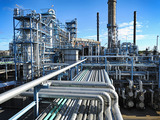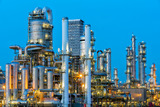Petrochemical exporting plays a pivotal role in the global economy, involving the trade of chemical products derived from petroleum and natural gas. These products serve as essential building blocks for various industries, including plastics, pharmaceuticals, textiles, and agriculture. As a key sector within the broader energy industry, petrochemicals contribute significantly to a nation's economic development and trade balance.
Major petrochemical-exporting nations
Major petrochemical-exporting nations, such as the United States, Saudi Arabia, and China, leverage their abundant access to raw materials and advanced processing technologies to dominate the market. The United States, for instance, has witnessed a surge in petrochemical exports driven by its shale gas boom, providing a competitive edge in production costs.
The petrochemical export landscape is influenced by geopolitical factors, regulatory frameworks, and global demand patterns. OPEC nations often exert influence through their control over oil production, impacting petrochemical feedstock prices. Additionally, environmental and sustainability concerns are reshaping the industry, prompting a shift towards green technologies and alternative feedstocks.
Despite the economic benefits, petrochemical exports face challenges. Fluctuating oil prices, trade tensions, and the rise of renewable energy sources pose uncertainties. Moreover, environmental awareness has led to increased scrutiny of the industry's ecological footprint, pressuring exporters to adopt more sustainable practices.
Strategic investments in research and development, as well as collaborations between governments and industry players, are crucial for the petrochemical sector's continued growth and adaptation to evolving market dynamics. Balancing economic gains with environmental responsibility is essential to ensure the sustainability of petrochemical exporting in the face of changing global priorities.
chemical products
Petrochemicals encompass a wide range of chemical products derived from petroleum and natural gas. Some key petrochemicals include:
1. Ethylene: The most widely produced petrochemical, ethylene serves as a building block for various plastics and synthetic materials.
2. Propylene: Used in the production of plastics, synthetic fibers, and resins, propylene is a versatile petrochemical.
3. Polyethylene and Polypropylene: These are polymers derived from ethylene and propylene, respectively, and are widely used in packaging materials, containers, and various plastic products.
4. Methanol: A basic chemical used in the production of plastics, paints, and as a fuel source.
5. Benzene: An aromatic hydrocarbon with applications in the production of styrene, which is crucial for manufacturing plastics and rubber.
6. Toluene: Used in the production of various chemicals, including solvents, paints, and adhesives.
7.Xylene: Commonly used as a solvent in the production of resins, plastics, and synthetic fibers.
8. Butadiene: Essential for the production of synthetic rubber and various types of plastics.
9. Methyl Tertiary Butyl Ether (MTBE): Used as an additive in gasoline to improve its octane rating.
10. Vinyl Chloride: The primary raw material for producing polyvinyl chloride (PVC), a widely used plastic in construction and other industries.

These petrochemicals undergo complex processes within refineries and petrochemical plants to produce a diverse array of products that form the backbone of modern industries. The demand for these chemicals is closely tied to economic activities, technological advancements, and societal needs. However, the industry is also facing increased scrutiny and pressure to adopt sustainable practices due to environmental concerns.
some common products
Petrochemicals are utilized in a wide range of products across various industries. Here are some common products where petrochemicals play a significant role:
1. Plastics: Petrochemicals are fundamental in the production of plastics such as polyethylene, polypropylene, PVC, and more. These plastics are used in packaging materials, containers, toys, medical devices, and numerous everyday items.
2. Synthetic Fibers: Petrochemicals like polyester, nylon, and acrylic are essential for the production of synthetic fibers used in clothing, carpets, and textiles.
3. Rubber: Petrochemical-derived products like styrene and butadiene are crucial in the production of synthetic rubber, which is used in tires, belts, hoses, and various automotive components.
4. Paints and Coatings: Chemicals like toluene and xylene are key ingredients in the production of paints, coatings, and adhesives.
5. Solvents: Petrochemicals serve as solvents in various applications, including cleaning products, degreasers, and industrial processes.
6. Fuel Additives: Methyl Tertiary Butyl Ether (MTBE) is used as a fuel additive to enhance the octane rating of gasoline.
7. Pharmaceuticals: Petrochemicals are used in the synthesis of pharmaceuticals and various medicinal products.
8.Detergents: Petrochemicals contribute to the production of surfactants and other components in detergents and cleaning products.
9. Fertilizers:Ammonia, derived from natural gas, is a key ingredient in the production of fertilizers for agriculture.
10. Construction Materials: Petrochemicals are used in the production of construction materials such as pipes, insulation, and adhesives.
The versatility of petrochemicals allows them to be integral to the production of a vast array of products that are essential in modern life. However, there is an increasing focus on finding more sustainable alternatives to reduce the environmental impact associated with the production and use of these chemicals.
Iran has traditionally been a significant player in the global petrochemical industry, leveraging its vast hydrocarbon resources to produce and export a wide range of petrochemical products. The country's petrochemical sector has seen considerable growth and development, with an extensive network of petrochemical plants and refineries.
Iran's petrochemical exports include products such as ethylene, propylene, polyethylene, polypropylene, methanol, and various other chemical derivatives. The country's strategic location and access to key markets in Asia and Europe contribute to its competitiveness in the global petrochemical trade.
However, Iran's petrochemical industry has faced challenges, including economic sanctions imposed by the international community. These sanctions have affected Iran's ability to attract foreign investments, acquire advanced technologies, and access global financial systems, impacting the overall growth and efficiency of its petrochemical sector.

Iran
Despite these challenges, Iran has sought to enhance its petrochemical capabilities through domestic investments and collaborations with international partners in regions less affected by sanctions. The country aims to capitalize on its abundant natural gas resources to expand its petrochemical production capacity and diversify its product portfolio.
The dynamics of Iran's petrochemical exports are influenced by geopolitical factors, global energy trends, and market demand. As geopolitical situations evolve and sanctions undergo changes, the trajectory of Iran's petrochemical industry in the global market continues to be subject to fluctuations and uncertainties.